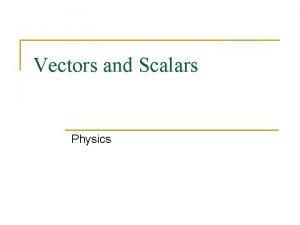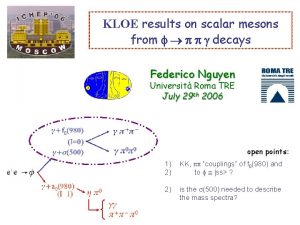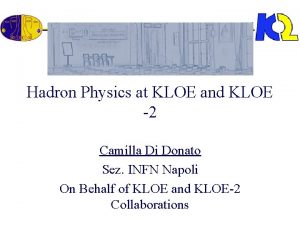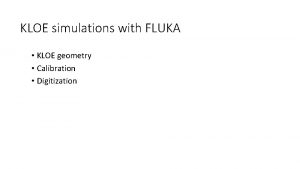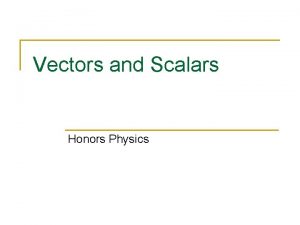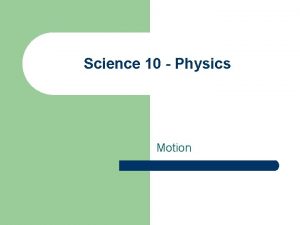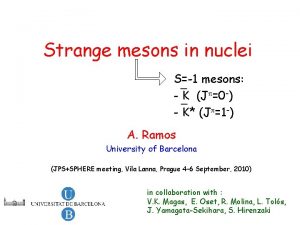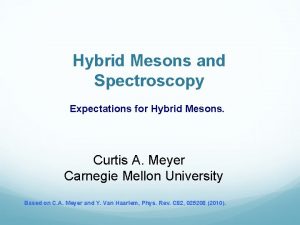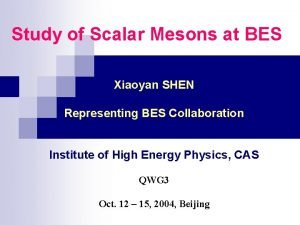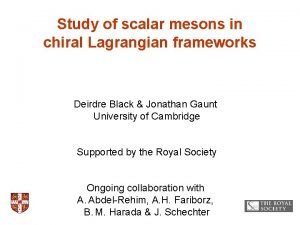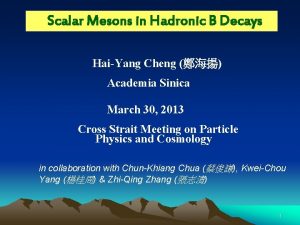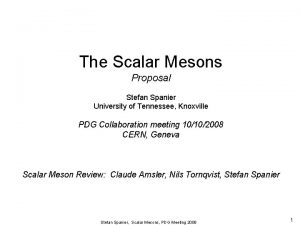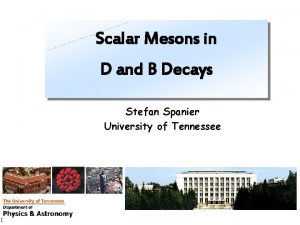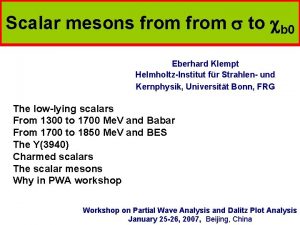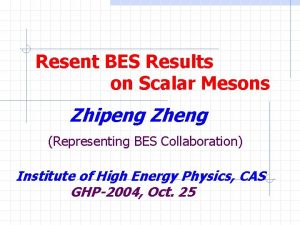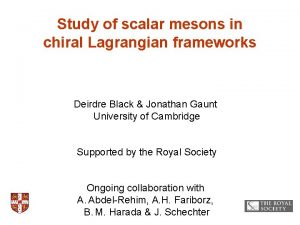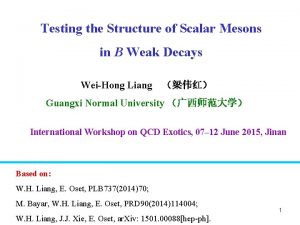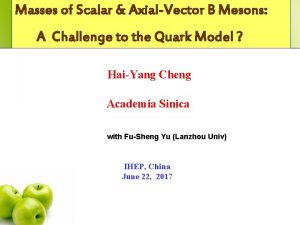Scalar Mesons Physics with the KLOE detector C
























- Slides: 24

Scalar Mesons Physics with the KLOE detector C. Bini Universita’ “La Sapienza” and INFN Roma For the KLOE collaboration Outline 1. Status of the KLOE experiment 2. “Hadron Physics” at a f - factory 3. Scalar Mesons at a f - factory : 4. Results 4. 1 p+p-g 4. 2 p 0 p 0 g 4. 3 hp 0 g 5. Summary and perspectives

1) Status of the KLOE experiment These days: end of f –peak run 2 fb-1 collected in the last two years. f 6 × 109 K+ - K- 3 × 109 KL - KS 2 × 109 h 6 × 107 f 0 , a 0 6 × 105 h’ 5 × 105 ANALYZED Program now: energy scan around the f + off-peak run s = 1 Ge. V: KLOE end by spring 2006

2) “Hadron Physics” at a f - factory Preview: analysis done and in progress (non Kaon physics) f hp 0 g Study of a 0(980) f p 0 g Study of f 0(980) + f 0(600) f hg , h’g h / h’ mixing f p+p-p 0 r+, -, 0 line shapes + “direct term” h ggg / h p+p- Upper limit on C, P, CP violating decays f e+e- / f m+m- f leptonic widths: lepton universality e+e- p+p- (rad. ret, ) Hadronic contribution to g-2 f p+p-g Study of f 0(980) + f 0(600) h p+p-p 0 Fit of Dalitz plot: Ch. PT test h p 0 gg Ch. PT test @ p 6 h, K 0 masses

3) Scalar Mesons at a f - factory How a f-factory can contribute to the understanding of the scalar mesons Mass (Me. V/c 2) f(1020) 1000 a 0(980) f 0(980) K*0(800) “k” 500 f 0(600) “s” 0 I=1/2 I=1 Scalar Mesons Spectroscopy: f 0(980), f 0(600) and a 0(980) are accessible (k not accessible) through f Sg; Questions: 1. Is f 0(600) needed to describe the mass spectra ? 2. “couplings”of f 0(980) and a 0(980) to f |ss> and to KK, pp and hp. 4 -quark vs. 2 -quark states

How to detect these radiative decays f f 0(980)g f a 0(980)g f f 0(600)g p+p-g p 0 g K+K-g [ 2 m(K)~m(f 0)~m(f) ] expected BR ~ 10 -6 K 0 g “ “ ~ 10 -8 hp 0 g K+K-g expected BR ~ 10 -6 K 0 g “ ~ 10 -8 p+p-g p 0 g General Comments: fits of mass spectra are needed to extract the signals: this requires a parametrization for the signal shape; the unreducible background is not fully known: a parametrization is required and some parameters have to be determined from the data themselves; sizeable interferences between signal and background;

How to extract the signal: 1. Electric Dipole Transitions: G(E 1) Eg 3 × |Mif(Eg)|2 2. Distortions due to KK thresholds (Flatte’-like). Kaon-loop (by N. N. Achasov): for each scalar meson S: g. Spp, g. SKK, MS No-Structure (by G. Isidori and L. Maiani): a modified BW + a polynomial continuum: gf. Sg, g. Spp, g. SKK, MS + pol. cont. parameters Scattering Amplitudes (by M. E. Boglione and M. R. Pennington) A (a 1+b 1 m 2+c 1 m 4) T(pp pp) + (a 1+b 1 m 2+c 1 m 4) T(pp KK) pole residual gf

Definition of the relevant couplings (S=f 0 or a 0): S to f gf. Sg (Ge. V-1) S to kaons g. SKK=g. SK+K-=g. SK 0 K 0 (Ge. V) f 0 to pp (I=0) gf 0 pp=√ 3/2 gf 0 p+p-=√ 3 gf 0 p 0 p 0 (Ge. V) a 0 to hp (I=1) ga 0 hp (Ge. V) Coupling ratio Rf 0=(gf 0 KK/ gf 0 p+p-)2 Ra 0=(ga 0 KK/ ga 0 hp)2 Kaon-loop K+ f p+ g K- p+ f 0, a 0 p- No-structure f f 0, a 0 pg

The unreducible backgrounds Unreducible backgrounds: (p+p- ): huge backgrounds: Initial state radiation (ISR) Final state radiation (FSR) f r±p± with r ± p±g (p 0 p 0): large backgrounds: e+e- wp 0 with w p 0 g f r 0 p 0 with r 0 p 0 g (hp 0): small backgrounds: e+e- wp 0 with w hg f r 0 p 0 with r 0 hg (p+p-) vs. (p 0 p 0): search for the “same amplitude” with a completely different background ! (hp 0) is the “cleanest” sample

4. 1) The p+p-g analysis I - Event selection: (a) 2 tracks with qt>45 o; missing momentum qpp>45 o (Large Angle); (b) Each track is pion-like (tracking, To. F and Shower shape): (c) 1 photon matching the missing momentum Particle identification: p vs. e and m (Likelihood: Tof and Shower shape) pions, muons (“trackmass”) pions muons electrons

II – The data sample 6. 7 × 105 events / 350 pb-1 @ √s = Mf 2. 2 × 104 events / 11 pb-1 “off-peak” m(pp) spectra: (blue) “Small angle” qpp<15 o; (red) “Large angle” qpp>45 o; “Large angle”: clear f 0(980) signal f 0(980) region m(pp) (Me. V) photon efficiency m(pp) (Me. V)

III - Fit to the m(pp) spectrum (491 bins, 1. 2 Me. V wide, 420 to 1009 Me. V) F= ISR + FSR + rp + scalar ± interference KL fit NS fit KL and NS fits: Good description in both cases of signal and background (KS); “negative” interference; f 0(600) doesn’t help.

Parameter uncertainties are dominated by the systematic errors: Comments: Mass value OK [ PDG 980 ± 10 Me. V ] R > 1 in both fits (in agreement with published values p 0 p 0 g) KL couplings >> NS couplings: effect of polynomial continuum NS suggests “large” coupling to the f (see following)

Scattering Amplitude Fit gf = 6. 6 × 10 -4 BR(f f 0(980)g) × BR(f 0(980) p+p-) ~ 3 × 10 -5 [ similar conclusion from BP analysis of p 0 p 0 g data (KLOE + SND)] Summarizing: The peak at ~980 Me. V is well interpreted in both KL and NS approaches as due to the decay f f 0(980)g with a negative interference with FSR. The couplings suggest the f 0(980) to be strongly coupled to kaons and to the f. No space for f 0(600). Scattering Amplitude gives a marginal agreement.

IV - The Forward-Backward asymmetry: A = (N(q+>90 o) – N(q+<90 o)) / sum p+p- system: Cross-section: A(ISR) C-odd A(FSR) & A(scalar) C-even |A(tot)|2 = |A(ISR)|2 + |A(FSR)|2 + |A(scalar)|2 + 2 Re[A(ISR) A(FSR)] + 2 Re[A(ISR) A(scalar)] + 2 Re[A(FSR) A(scalar)] Pion polar angle distributions (Red) = p+ (Blue) = p- Effect of the scalar amplitude on the charge asymmetry: Plot of A in slices of m(pp); Comparison with simulation with and without the scalar amplitude.

FB asymmetry vs. m(pp): Clear signal ~ 980 Me. V Interesting comparison with simulation: Data Simulation FSR+ISR+ scalar(KL) The simulation provides a “qualitative” description of: f 0(980) region behaviour (the signal is reproduced); Low mass behaviour (low mass tail of the signal. Remarkable result: not a fit but an absolute prediction

V – Cross section dependence on √s: Absolute prediction based on KL fit parameters Data: on-peak Data: off-peak KL absolute prediction Based on fit parameters Concluding remark: p+p-g is a powerful tool to test scalar production: mass spectrum, FB asym. and s dependence KLOE has now collected 2 fb-1 at f factor 6 more. Is now starting a finer energy scan around the f

4. 2) The p 0 p 0 g analysis I - event selection: 5 photons with qg>21 o ; no tracks; Kinematic fit energy-momentum conservation; Kinematic fit p 0 masses: choice of the pairing. 4 × 105 events / 450 pb-1 2002 analysis scheme: 1. Reject wp 0 events interference is neglected; 2. 1 -dim analysis: fit with KL The spectrum is dominated by w p 0 g KLOE PLB 537 (2002) 21

New analysis scheme: 1. Removed the m(w) cut : wp 0 are now in the sample 2. Bi-dimensional analysis [ Dalitz-plot m(p 0 p 0) – m(p 0 g) ] 3. New treatment of systematics [ pairing problem. . . ] 4. Improved VDM parametrization of wp 0

II – Fit of the Dalitz plot (still preliminary results) KL and NS fits in progress Residuals vs. DP position Comments: Data- fit comparison (on projections) 1. VDM part still not perfect (see residuals); 2. Scalar part ok BUT f 0(600) is still needed in KL fit [p(c 2) ~ 10 -4 30% !]; 3. f 0(980) parameters agree with p+p-g analysis again R > 1 (gf. KK > gfp+p-).

4. 3) The hp 0 g analysis I – The data samples: out of 400 pb-1 : Statistics of PLB 536 (2002) 209 × 20 (h gg) Improved reducible background subtraction: 2. 2 × 104 events [ ½ are signal] Red = signal Other colors= bck (h p+p-p 0) almost “background free” 4100 events [ bck < 3%] Full pts. = “ 20 pb-1” data Empty pts. = “ 400 pb-1” data M(hp) (Me. V)

II – The combined fit Simultaneous fit of h gg and h p+p-p 0 channels: ratio of BR is fixed Pts. = data, hist = fit (including smearing) KL fit NS fit The spectra are dominated by the a 0 production: both models are able to reproduce them

Preliminary results of the fits (KL and NS): KL fit gfa 0 g (Ge. V-1) NS fit 1. 9 ga 0 K+K- (Ge. V) 2. 3 1. 9 Ga 0 hp (Ge. V) 2. 6 2. 2 Comments: gfa 0 g ~ in agreement with f 0 value Ra 0= 0. 78 (KL) and 0. 74 (NS) < 1

5) Summary and Perspectives The KLOE scalar analysis is not yet completed. However: 1. f 0(600): required in the p 0 p 0 channel not in the p+p- one: no clear answer by now. 2. Couplings: both NS and KL fits indicate Rf 0 =(gf 0 K+K-/ gf 0 p+p-)2 = 2 ÷ 4 Ra 0 = (ga 0 K+K-/ ga 0 hp-)2 = 0. 7 ÷ 0. 8 from NS analysis: large couplings to the f gff 0 g = 1. 2 ÷ 2. 0 gfa 0 g ~ 1. 9 (unc. evaluation in progress) in any case >> gfpg gfh’g = (0. 1 0. 7).

KLOE perspectives on scalar mesons 1. Conclude analysis on 2001 -2002 data sample for f 0(980) (neutral final states) and a 0(980). 2. With 2000 pb-1 @ f peak: improvement expected for f 0 → p+pcombined fit p+p- AND p 0 p 0 search for f 0, a 0 KK 3. With new forthcoming energy scan data improved study of the √s-dependence of the cross-section; Off-peak: “test run” of gg p 0 p 0
 Cqc kloe poster
Cqc kloe poster Scalar physics
Scalar physics University physics with modern physics fifteenth edition
University physics with modern physics fifteenth edition Ia ideas physics
Ia ideas physics Why does it happen
Why does it happen Vẽ hình chiếu đứng bằng cạnh của vật thể
Vẽ hình chiếu đứng bằng cạnh của vật thể Glasgow thang điểm
Glasgow thang điểm đại từ thay thế
đại từ thay thế Quá trình desamine hóa có thể tạo ra
Quá trình desamine hóa có thể tạo ra Công thức tính độ biến thiên đông lượng
Công thức tính độ biến thiên đông lượng Khi nào hổ con có thể sống độc lập
Khi nào hổ con có thể sống độc lập Thế nào là mạng điện lắp đặt kiểu nổi
Thế nào là mạng điện lắp đặt kiểu nổi Các châu lục và đại dương trên thế giới
Các châu lục và đại dương trên thế giới Dot
Dot Thế nào là sự mỏi cơ
Thế nào là sự mỏi cơ Bổ thể
Bổ thể Phản ứng thế ankan
Phản ứng thế ankan Thiếu nhi thế giới liên hoan
Thiếu nhi thế giới liên hoan điện thế nghỉ
điện thế nghỉ Chúa yêu trần thế alleluia
Chúa yêu trần thế alleluia Một số thể thơ truyền thống
Một số thể thơ truyền thống Trời xanh đây là của chúng ta thể thơ
Trời xanh đây là của chúng ta thể thơ Hệ hô hấp
Hệ hô hấp Số nguyên tố là gì
Số nguyên tố là gì đặc điểm cơ thể của người tối cổ
đặc điểm cơ thể của người tối cổ

